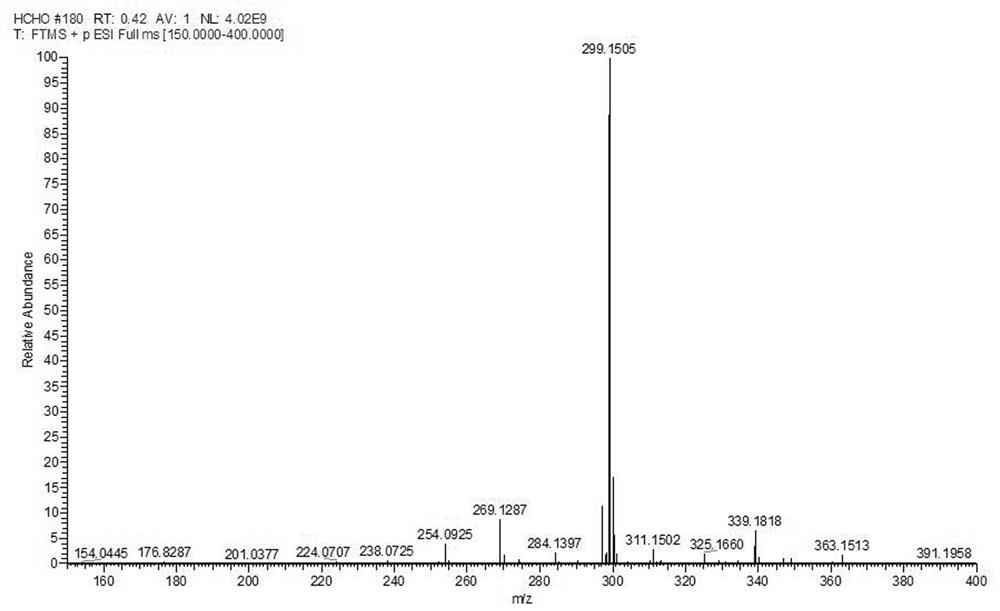Fluorescent probe FAL1 for formaldehyde and pH dual-function detection as well as preparation method and application of fluorescent probe FAL1
A fluorescent probe, FAL1 technology, applied in the field of chemical detection, can solve the problems affecting the uptake and curative effect of pH-sensitive chemotherapy drugs, and achieve the effects of strong photochemical stability, high quantum efficiency, and easy chemical modification
- Summary
- Abstract
- Description
- Claims
- Application Information
AI Technical Summary
Problems solved by technology
Method used
Image
Examples
Embodiment 1
[0040] The preparation method of the fluorescent probe FAL1 for dual-function detection of formaldehyde and pH, the specific steps are:
[0041] (1) Intermediate 1 was prepared by dissolving 4-bromo-1,8-naphthalene anhydride (2.77 g, 10 mmol) and dimethyldiamine (2.644 g, 30 mmol) in ethanol (50 mL) , stirred and reacted for 4 hours under reflux conditions, a large amount of solids were precipitated after cooling to room temperature, and 1.384 g of light yellow solids were obtained by suction filtration, which was intermediate 1, and the yield was 40%;
[0042] (2) The preparation method of probe FAL1 was as follows: intermediate 1 (347.2 mg, 1 mmol) and 80% hydrazine hydrate (363 μL, 6 mmol) were dissolved in ethylene glycol monomethyl ether (15 mL) solution, heated React under reflux conditions for 15 hours. After cooling to room temperature, pour the mixed solution into pure water to precipitate a large amount of solids. Suction filter and wash the obtained solids with ethy...
Embodiment 2
[0047] The preparation method of the fluorescent probe FAL1 for dual-function detection of formaldehyde and pH, the specific steps are:
[0048] (1) Intermediate 1 was prepared by dissolving 4-bromo-1,8-naphthalene anhydride (2.77 g, 10 mmol) and dimethyldiamine (3.525 g, 40 mmol) in ethanol (50 mL) , stirring and reacting for 6 hours under reflux conditions, after cooling to room temperature, a large amount of solids were precipitated, and 1.73 g of light yellow solids were obtained by suction filtration, which was intermediate 1, and the yield was 50%;
[0049] (2) The preparation method of probe FAL1 was as follows: intermediate 1 (347.2 mg, 1 mmol) and 80% hydrazine hydrate (242 μL, 4 mmol) were dissolved in ethylene glycol monomethyl ether (15 mL) solution, heated Reaction under reflux conditions for 12 hours, after cooling to room temperature, pour the mixed solution into pure water to precipitate a large amount of solids, suction filter and wash the obtained solids with...
Embodiment 3
[0054] The preparation method of the fluorescent probe FAL1 for dual-function detection of formaldehyde and pH, the specific steps are:
[0055] (1) Intermediate 1 was prepared by dissolving 4-bromo-1,8-naphthalene anhydride (2.77 g, 10 mmol) and dimethyldiamine (7.05 g, 80 mmol) in ethanol (50 mL) , stirred and reacted for 8 hours under reflux conditions, and a large amount of solids were precipitated after cooling to room temperature, and 2.08 g of light yellow solids were obtained by suction filtration, which was intermediate 1, and the yield was 60%;
[0056] (2) The preparation method of probe FAL1 was as follows: intermediate 1 (347.2 mg, 1 mmol) and 80% hydrazine hydrate (484 μL, 8 mmol) were dissolved in ethylene glycol monomethyl ether (15 mL) solution, heated React under reflux conditions for 10 hours. After cooling to room temperature, pour the mixed solution into pure water to precipitate a large amount of solids. Suction filter and wash the obtained solids with et...
PUM
 Login to View More
Login to View More Abstract
Description
Claims
Application Information
 Login to View More
Login to View More - R&D
- Intellectual Property
- Life Sciences
- Materials
- Tech Scout
- Unparalleled Data Quality
- Higher Quality Content
- 60% Fewer Hallucinations
Browse by: Latest US Patents, China's latest patents, Technical Efficacy Thesaurus, Application Domain, Technology Topic, Popular Technical Reports.
© 2025 PatSnap. All rights reserved.Legal|Privacy policy|Modern Slavery Act Transparency Statement|Sitemap|About US| Contact US: help@patsnap.com



